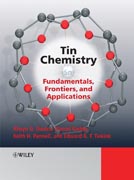
New and exciting research on tin is being generated on an annual basis from all parts of the world. Tin Chemistry collects, in one comprehensive volume, authoritative and concise snapshots of modern tin chemistry in a full range of applications. Over forty of the leading tin chemistry experts have contributed reviews on the applications as well as fundamentals of modern tin chemistry. The book provides an essential overview of modern perspectives on this important element for academic and industrial researchers, postgraduates, and final-year undergraduate students. INDICE: 1. Introduction and overview (A. G. Davies). 2. Fundamentals in tin chemistry. 2.1 NMR of tin compounds (Bernd Wrackmeyer). 2.2 Sn(II) clusters (Tris Chivers and Dana Eisler). 2.3 Monorganotin oxo-clusters (François Ribot). 2.4 Organotin carboxylate and -sulfonate clusters (Vadapalli Chand Rasekhar). 2.5 Macrocyclic and supramolecular chemistry of organotin compounds (HerbertHöpfl). 2.6 Tin Zintl Ions: Synthesis, Structures, and Reactivity (Slavi Sevov). 2.7 Stable stannyl cations in condensed phase (Joe Lambert). 2.8 Preparation and coordination chemistry of mono- and bidentate stannylenes (Alexander V.Zabula and F. Ekkehardt Hahn). 2.9 Stannenes, distannenes and stannynes (Norihiro Tokitoh and Yoshiyuki Mizuhata). 2.10 Distannoxanes (Klaus Jurkschat). 2.11 Unusual bonds and coordination geometries (Raymundo Cea-Olivares). 2.12 Tin(II) heterobimetallic and oligometallic derivatives (Muhammad Mazhar). 2.13 Computational Methods for Organotin Compounds (Sarah Whittleton, Russell J. Boyd, and T. Bruce Grindley). 3. Materials Chemistry and Structural Chemistry of tin compounds. 3.1 Tin compounds for CVD (Geraldo Lima). 3.2 Class II Tin-BasedHybrid Materials Prepared From Alkynyltin Precursors (Thierry Toupance). 3.3 Organotin compounds as PVC stabilizers (Esen Arkis). 3.4 Organotin compounds as anion-selective carriers in chemical sensors (Nikos Chaniotakis). 3.5 Tin compounds as flame retardants and smoke suppressants (Paul Cusack). 3.6 Quadratic nonlinear optical properties in tin-based compounds (Pascal G. Lacroix). 3.7Tin-based hybrid materials (Bernard Jousseaume). 3.8 Organotin polymers and related materials (Keith Pannell and Sharma). 3.9 Intermolecular tinÀ-aryl interactions: fact or artifact*? A new bonding motif for supramolecular self-assembly in organotin compounds (Ionel Haiduc, Edward Tiekink and Julio Zukerman-Schpector). 4. Medicinal/Biocidal Applications of tin compounds and Environmental Aspects. 4.1 The cardiovascular activity of organotin compounds (Mala Nath).4.2 Organotins: Insecticidal and larvicidal activity (George Eng and Xueqing Song). 4.3 Antifungal activity of organotin compounds (Heloisa Beraldo and Geraldo M. de Lima). 4.4 Chemical and biotechnological developments in organotin cancer chemotherapy (Claudio Pettinariÿ and Fabio Marchetti). 4.5 Impact of organotin compounds on the function of human natural killer cells (Margaret M. Whalen). 4.6 Biological aspects of organotins: perspective in structural and molecular biology (Norberto Farfán, Hiram Beltran and Rosa Santillan). 5. Tin inOrganic Synthesis. 5.1 Applications of Organotin Derivatives for CarbohydrateSynthesis (T. Bruce Grindley). 5.2 Reactions of SE? Substitution for Organostannanes in Organic Synthesis (David R. Williams and Partha P. Nag). 5.3 Organotin compounds for Carbon-Carbon Cross-Coupling (Pablo Espinet and Miroslav Genov). 5.4 Cross-Coupling of Organotin compounds for Carbon-Carbon Bond Formation: Applications in Total Synthesis (Antonio Echavarren). 5.5 New Trends in theSynthesis of Solid-Supported Organotin Reagents and Interest of their Use in Organic Synthesis in a Concept of Green Chemistry (Jean-Mathieu Chrétien, Jeremy D. Kilburn, Françoise Zammattio, Erwan Le Grognec and Jean-Paul Quintard). 5.6 Palladium Catalysed Cascade Cyclisation-Anion Capture Processes Employing Pre- and In Situ-Formed Organostannanes (Ronald Grigg and V. Sridharan). 5.7 Carbostannylations of carbon-carbon unsaturated bonds (Eiji Shirakawa). 5.8 Green Organostannane Chemistry: an Oxymoron (David Young)? 6. Tin in Catalysis. 6.1 Green organotin catalysts (Junzo Otera, Monique Biesemans, Vanja Pinoie, Kevin Poelmans and Rudolph Willem). 6.2 Organotin catalysts for isocyanate reactions (Werner J. Blank and Edward T. Hessell). 6.3 Catalysis of reactions of allyltin compounds and organotin phenoxides by lithium perchlorate (Wojciech J. Kinart and Cezary M. Kinart).
- ISBN: 978-0-470-51771-0
- Editorial: John Wiley & Sons
- Encuadernacion: Cartoné
- Páginas: 648
- Fecha Publicación: 01/08/2008
- Nº Volúmenes: 1
- Idioma: Inglés
